Looking in Uri’s mouth – New Scientist – October 17, 1974
Feature in the “New Scientist”, October 17, 1974
![]() This feature is just one ludicrous example showing to what extent some scientists, magicans and writers indulged in, to explain how Uri Geller demonstrates his telepathic abilities.
This feature is just one ludicrous example showing to what extent some scientists, magicans and writers indulged in, to explain how Uri Geller demonstrates his telepathic abilities.
Incidentally, “New Scientist” is known to be a very serious scientific magazine.
The final question that must be answered is how the SRI paper stacks up against Occam’s Razor – is there a plausible normal method by which Geller could have done his two successful tests at SRI? Plausibility is hard to define this situation, but it must take into account anything that can be done with the assistance of Dr Andrija Puharich.
As the box on the next page shows, Puharich is a medical electronics expert who developed a radio receiver which can be hidden in a tooth. It must therefore be considered plausible that Uri has a miniature radio receiver concealed on his person. Even if it is not hidden in his teeth, it could easily be hidden in his hair or in a wristwatch which he presses against his chin to hear. The possibilities are limitless, especially if Uri is not carefully searched. Because Uri constantly runs his hands through his hair and across his face, no one would notice him listening to his Dick Tracy wrist radio – nor, because of the direct nerve stimulation, would anyone else hear it.
There are two small pieces of evidence that give some credence to this suggestion. The most obvious is that all of Uri’s drawings are representations of words which would describe the target drawing, and thus are consistent with radiocommunication. These cond occurred in January when Puharich was telling me that in any test Uri should be “properly examined” for hidden devices. But then he suddenly added:
“But I know Uri will not submit to excessive examination like, total body X-radiation”. In other words, Uri will not permit the only test for a Puharich implanted radio receiver.
To some measure, SRI has protected against radio transmission by working with shielded rooms for the picture drawing tests. But have they succeeded, or is it possible to penetrate the room to a radio?
To answer this question, I consulted Robert King, a senior lecturer at Imperial College, London. King wrote the specifications for all three shielded rooms in the College’s Electrical Engineering Department. King was dogmatic: “I could get information into any shielded room.” The reason, he explained, is that shielded rooms are simply not designed to protect against secretive attempts to get information through.
The SRI paper gives only vague information on the room in which most of the tests were done (SI in the Table, p 179)-it says only that it is “a double walled steel room, locked by means of an inner and outer door”. The second room (S2 in the Table, p 179) is a “double-walled, copper-screen Faraday cage” which “provides 120 dB attenuation for plane wave radio frequency radiation over a range of 15 KHz to 1 GHz. For magnetic fields the attenuation is 68 dB at 15 KHz and decreases to 3 dB at.60 Hz.”
King said that this is typical of screening for shielded rooms, and provides the key to getting data inside in this case. Attenuation drops off very rapidly at the very small wavelengths about 1 GHz, he said, so that microwaves of 10 GHz or more provide a good possibility.
Hearing with a tooth
The dream of spy writers, a radio receiver that can be concealed in a tooth, actually exists and was invented by Andrija Henry Puharich – the man who found Geller in Israel and brought him to the US. Puharich is a wealthy 56-year-old MD who holds 56 patents, primarily in medical electronics. Since 1960 his inventions have related primarily to hearing aids for people with nerve deafness.
But Puharich’s hearing aid is a unique device which stimulates certain facial nerves just as the organ of Corti stimulates auditory nerves, and the person can actually hear normally without using his or her ears at all. The facial hearing system will work with nerves on the face and neck, on the tongue, and in the sinuses, Puharich claims. But for cosmetic reasons, the nerves in a living tooth are best.
“The invention comprises an element applied to a viable tooth, for receiving electromagnetic signals at radio frequency, and a transducer element coupled with a receiving element and with live nerve endings of the tooth for converting the electromagnetic signals to electric signals at audio frequency, and imparting the electrical signals to the nerve endings of the tooth for transmission to the brain,” according to US Patent 2995633 issued 8 August, 1961.
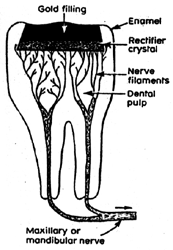
Normally, the user would carry a small transmitter in his pocket which would pick up sounds and transmit them to the tooth. But Puharich and co-inventor Joseph Lawrence noted in US Patent 3267931, issued 23 August, 1966, that the device “may, of course, be adapted for longer range transmission of radio frequency signals”.
Although the device will receive radio signals directly, it works best with an amplifier. In the initial patent, this amplifier is relatively large,
concealed in two false teeth next to the viable one with the implant (Figure 2). But by 1964, Puharich had modified the amplifier entry (US Patent 3 156 787) to be mounted on the one tooth. The drawing (Figure 3) is greatly exaggerated in size to facilitate description. . . . The entire assembly . . .advantageously is of wafer-thin construction, so as to be unobtrusively concealed with the cap. . . . It is contemplated that the various components of the system of the invention may be further reduced, to inicro-miniature proportions, through the use of so-called ‘thin film’ circuit fabrication techniques”.
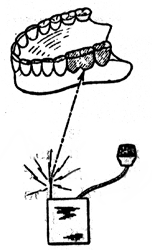
The amplification in the 1964 and 1966 patents is provided by a feedback loop within the mouth, using either two different teeth (Figure 4 from the 1966 patent) or the tongue pressed against an exposed terminal on the back of the tooth (left of tooth in Figure 3). This latter form has the interesting side effect that amplification only works when the tongue is pressed against the tooth, and thus the wearer can listen selectively and be undisturbed by radio signals at other times.
In another version of the device, described in the 1966 patent, an electrode “about the size of a penny which is covered on its operative surf ace with a thin film of Mylar” could be pressed against the skin in one of several identifiable areas of the head and neck to stimulate facial nerves and produce the same effect of hearing. The electrode is connected to a receiver similar to the one mounted in the tooth. The feedback circuit is completed by a connection to any point on the body. For example, a quite small device held in the hand could be pressed against the face.

In this drawing, the amplifier “is greatly exaggerated in size to facilitate description” and would, in fact, be hidden under the tooth cap. The amplifier has a terminal on the left which must be touched with the tongue to complete the circuit. Drawing from US Patent 3 156 787
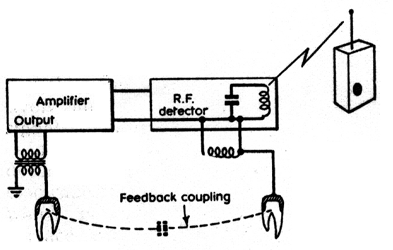
In this drawing, the amplifier “is greatly exaggerated in size to facilitate description” and would, in fact, be hidden under the tooth cap. The amplifier has a terminal on the left which must be touched with the tongue to complete the circuit. Drawing from US Patent 3 156 787
Microwaves
ves have one important property: they are reflected by metal. Thus, microwaves are often used with waveguides – long metal boxes which will carry the microwaves virtually without loss around tortuous routes. The air conditioning system probably used in SRI buildings would make an especially good waveguide – a transmitter placed anywhere in the air conditioning would transmit to all linked offices. Naturally, airconditioning ducts entering a shielded room have special baffles to screen out radio waves – but these are highly, ineffective in the microwave range.
On the other hand, microwave transmitting equipment can be miniaturised and draw very little power. A microwave transmitter for this sort of purpose need be no bigger than a cigarette pack. And even though Puharich in his patents talks about his tooth receiver working in the MHz range, it should work just as well in the GHz range. In the configuration where the tongue is part of the amplifier, Geller would even be able to turn it on and off at will, and thus not be affected by possible continuing transmissions.
How would such a radio be used?
Perhaps the simplest way would be to use it to, bug the room in which the target picture was being viewed. Targ and Puthoff were so anxious to please. Uri that they would not have quibbled with a request from Uri to describe the picture out loud after they drew it – after all, as they say in their paper, the shielded room provided “acoustic isolation”. Another choice would involve Shipi Strang, Uri’s inseparable companion. According to Puharich in his book Uri, Geller first met Shipi in 1967 when Uri was serving as a counsellor at a summer camp for teenage boys, and one of his charges was Shipi. Uri hit it off well with both Shipi and Shipi’s sister Hannah, and Uri and Shipi soon became constant companions. It was Shipi who first convinced Uri to perform, according to Puharich. And Shipi went with Uri to the US. Although Targ and Puthoff do not mention it at all in their paper, Shipi was constantly under foot during the tests – at least sometimes accompanying the experimenters during actual experiments. Shipi could easily have signalled Uri in code with a transmitter hidden in his pocket, for example.
The SRI paper also notes that ” the picture was drawn and brought near the shielded room” which suggests that Shipi might have had other chances to see it as well. In the chaos of the computer room for tests 11 to 13, Shipi would hardly have been noticed while the picture was being decided on and drawn. The SRI data shows some support for this sort of hypothesis-when the drawings were under the control of an outsider who would be less likely to accede to Geller’s requests and the presence of Shipi, Uri failed (Trials 5, 6, and 7). Even if this particular technique will not work, Puharich could surely find a simple way. Four other possibilities came to mind in discussions with King: 1) Higher frequency microwaves would pass through the cracks between the steel plates and around the door. Indeed, King notes that the space around a metal door would provide a particularly good waveguide. With a transmitter anywhere in the room directly outside the shielded room, signals would penetrate in this way. 2) To get electricity into a shielded room (for lights) without any radio transients, the normal procedure is to put a steel plate (usually the room wall) between two sides of a transformer. The 60 Hz magnetic field penetrates, whereas radio fields would not (this is supported by the fact that the copper screened room shows only a 3 dB loss to magnetic fields at 60 Hz). Therefore, King suggests low frequency magnetic induction transmission of data. Frequencies of 5-10 Hz should pass through double steel plates without unacceptable losses.
The transmitter coil could be concealed in a briefcase left sitting next to the wall of the shielded room. GeUer would have a coil of wire (for an aerial) under his belt or even hidden behind his teeth, and would stand close to the inner wall. During a 30 minutes test, large amounts of information could be transmitted by simple code. 3) If SRI has not properly shielded the mains current supply to the room, it would be possible to send radio signals along the mains (just this system is used for internal radio systems in universities, hospitals, and the like). This could be done with a transmitter smaller than a cigarette pack plugged into any outlet in the building. Geller would simply touch an electric wire inside the cage and his body would act as an aerial for the tooth radio. 4) There is an intercom connecting the inside of the cage with the outside. This could be like a telephone and have a filter to cut out everything above 3 KHz. But if it does not, it too could be used to carry radio signals into the room with the transmitter simply clipped onto the communications wire. The preceding discussion applies only to the extremely difficult problem of the shielded room. The other successful test guessing the die can be much more easily solved by radio.
Mr Hubert Caddy of the International Magic Studio, London, tells me that for several years it has been possible to buy a dice for about £30 which radios which face is up. It would not have been too difficult for Uri to have given SRI a normnal die that looked like the radio die, let them mark the normal die as they wanted, and then simply mark the radio die in the same way and switch. Naturally, this all depends on the cooperation of Puharich in perpetrating fraud. Why would he do so? In his book Uri, Puharich reports that extra-terrestrial powers called Hoova speak to him through a voice called Speera, and have done so for longer than he has known Uri. Uri’s power, he says, comes from Hoova. To have any hope of having this report accepted, Puharich needs Uri’s success. If Uri came to Puharich and said “Andrija, I have known you for a year now and never once have I cheated you. Now they are asking me to do things I may not always be able to do, but if I fall no one will believe in Hoova. ‘You are a great inventor – give me something to help me just once in a while.” In his book, Puharich tells of often hearing the voice of Spectra, and if Uri’s request came via Spectra, Puharich would be sure to obey. Thus, Puharich need not be a party to a widespread and continuing fraud to have helped Uri in some way.
I have no proof that Uri did do his drawings in this way. But it fits the data at least as well as the Targ-Puthoff paranormal explanation. By Occam’s Razor it is only necessary to show that plausible normal explanations have not been excluded. To be sure, by what might be considered a reverse Occam’s Razor, it must also be shown that the route to the normal explanation is not more complex than simply accepting the paranormal: But Puharich takes the plausible virtually into the realm of science fiction.

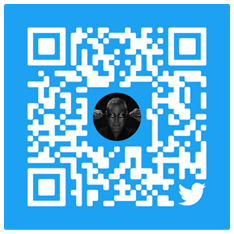
Latest Articles
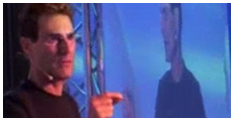
Motivational Inspirational Speaker
Motivational, inspirational, empowering compelling 'infotainment' which leaves the audience amazed, mesmerized, motivated, enthusiastic, revitalised and with a much improved positive mental attitude, state of mind & self-belief.



















